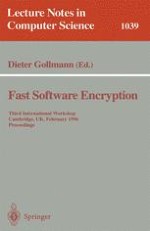This book constitutes the refereed proceedings of the Third International Workshop on Fast Software Encryption; this workshop was held in conjunction with the program on computer security, cryptology, and coding theory at the Isaac Newton Institute in Cambridge, UK in February 1996.
The 18 revised papers presented were carefully selected for inclusion in the volume by the program committee. They report the state of the art in the field of fast encryption algorithms and are organized in sections on block cipher analysis, applications, hash functions, block cipher proposals, correlation analysis, and design criteria for block ciphers.
